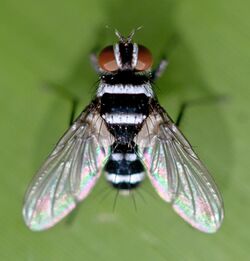Biology:Trigonospila
| Trigonospila | |
|---|---|

| |
| Scientific classification | |
| Domain: | Eukaryota |
| Kingdom: | Animalia |
| Phylum: | Arthropoda |
| Class: | Insecta |
| Order: | Diptera |
| Family: | Tachinidae |
| Subfamily: | Exoristinae |
| Tribe: | Blondeliini |
| Genus: | Trigonospila Pokorny, 1886[1] |
| Type species | |
| Trigonospila picta Pokorny, 1886[1]
| |
| Synonyms | |
Trigonospila is a small genus of parasitic flies in the family Tachinidae.[8][9][10]
Distribution
The genus has a worldwide distribution, but is particularly common in Australia . In Australia, T. brevifacies and T. cingulata are common within their respective ranges and can often be found resting on vegetation. They have been reported in some environments to be the most common conspicuous fly species.[11] In Australia, Trigonospila have been collected in all mainland states and territories, Tasmania, and some large offshore islands including Kangaroo Island in South Australia, and Brampton Island in Queensland.
Identification
Trigonospila are strikingly patterned flies; primarily black with pearly whitish to golden transverse bars on the thorax and abdomen. There are two whitish bars on the thorax; one adjacent to the transverse suture, and the second adjacent to the scutellum. There may also be a white triangle on the tip of the scutellum, and the subscutellum is usually white. Abdominal colouration varies between species however it is typical that there are three whitish bars on the abdomen; one at the anterior margin of each the third, fourth, and fifth abdominal tergites. The width of these bars differs between species.[11]
Biocontrol applications
T. brevifacies is a polyphagous parasitoid of the larvae of Lepidoptera and is native to the eastern states of Australia with a range extending from Tasmania to southern Queensland and possibly as far west as South Australia. T. brevifacies has been deployed in New Zealand as a biocontrol agent of a number of agricultural pests including the light brown apple moth Epiphyas postvittana (Lepidoptera : Tortricidae) and the potato tuber moth Phthorimaea operculella (Lepidoptera : Gelechiidae).[10]
T. cingulata and T. fasciata are believed to be parasitoids of chrysomelid beetles in the genus Paropsis,[10] some of which may be pests of agriculture or forestry.
Species
- Trigonospila bimaculata (Villeneuve, 1935)[12]
- Trigonospila braueri (Townsend, 1933)[4]
- Trigonospila brevifacies (Hardy, 1934)
- Trigonospila cingulata (Macquart, 1851)
- Trigonospila edwinbermudezi Fleming & Wood, 2015[13]
- Trigonospila erilis (Reinhard, 1943)[7]
- Trigonospila exigua (Villeneuve, 1935)[12]
- Trigonospila fasciata (Hardy, 1934)
- Trigonospila integra (Villeneuve, 1935)[12]
- Trigonospila josemariamoragai Fleming & Wood, 2015[13]
- Trigonospila ludio (Zetterstedt, 1849)
- Trigonospila melaleuca (Wulp, 1890)[14]
- Trigonospila mista (Villeneuve, 1913)[15]
- Trigonospila pallipes (Reinhard, 1953)
- Trigonospila panamensis (Townsend, 1919)[2]
- Trigonospila prasius Mesnil, 1977
- Trigonospila transvittata (Pandellé, 1896)[16]
- Trigonospila trinitatis (Thompson, 1963)
- Trigonospila unicaldasi Vinasco, Vallejo & Soto, 2017[17]
- Trigonospila uniformis Fleming & Wood, 2015[13]
- Trigonospila verticalis (Reinhard, 1953)
- Trigonospila vittigera (Coquillett, 1898)
References
- ↑ 1.0 1.1 Pokorny, E. (1886). "Vier neue österreichische Dipteren". Wiener Entomologische Zeitung 5: 191–196. doi:10.5962/bhl.part.20582. https://www.biodiversitylibrary.org/page/11970542#page/217/mode/1up. Retrieved 13 April 2022.
- ↑ 2.0 2.1 Townsend, C.H.T. (1919). "New muscoid genera, species and synonymy (Diptera). [Concl."]. Insecutor Inscitiae Menstruus 6 [1918]: 157–182. https://www.biodiversitylibrary.org/page/8197836#page/393/mode/1up. Retrieved 1 April 2022.
- ↑ Brauer, F.; Bergenstamm, J. E. von (1891). "Die Zweiflugler des Kaiserlichen Museums zu Wien. V. Vorarbeiten zu einer Monographie der Muscaria Schizometopa (exclusive Anthomyidae)". F. Tempsky, Wien: 142.
- ↑ 4.0 4.1 Townsend, C. H. T. (1933). "New genera and species of Old World oestromuscoid flies". Journal of the New York Entomological Society 40: 439–479.
- ↑ Pandellé, Louis (1895). "Études sur les Muscides de France. IIe partie (suite)". Revue d'entomologie 13: 1–113.
- ↑ Townsend, C.H.T. (1927). "New muscoid flies in the collection of the Deutsches Entomologisches Institut in Berlin". Entomologische Mitteilungen 16: 277–287. https://www.zobodat.at/pdf/Entomologische-Mitteilungen_16_1927_0277-0287.pdf. Retrieved 30 March 2022.
- ↑ 7.0 7.1 Reinhard, H.J. (1943). "New Tachinidae from northeastern United States (Diptera)". Bulletin of the Brooklyn Entomological Society 38: 78–90.
- ↑ O’Hara, James E.; Shannon, J. Henderson; D. Monty, Wood (5 March 2020). "World Checklist of the Tachinidae". http://www.nadsdiptera.org/Tach/WorldTachs/Checklist/Tachchlist_ver2.1.pdf.
- ↑ O'Hara, J.E.; Shima, H.; Zhang, C. (2009). "Annotated catalogue of the Tachinidae (Insecta: Diptera) of China". Zootaxa 2190: 1–236. doi:10.11646/zootaxa.2190.1.1. https://www.mapress.com/zootaxa/2009/f/zt02190p236.pdf. Retrieved 8 March 2022.
- ↑ 10.0 10.1 10.2 Crosskey, R.W. (1973). "A conspectus of the Tachinidae (Diptera) of Australia, including keys to the supraspecific taxa and taxonomic and host catalogues". Bulletin of the British Museum (Natural History), Entomology Series Supplement 21: –1221.
- ↑ 11.0 11.1 Hardy, G.M. (1934). "Notes on Australian Muscoidea (Calyptrata)". Proceedings of the Royal Society of Queensland (The Royal Society of Queensland) 45: 30–37. doi:10.5962/p.272112.
- ↑ 12.0 12.1 12.2 Villeneuve, J. (1935). "Myodaires supérieurs africains inédits". Revue de Zoologie et de Botanique Africaines 27: 136–143. https://biblio.naturalsciences.be/rbins-publications/bulletin-of-the-royal-belgian-natural-history-museum/bulletin-of-the-royal-belgian-natural-history-museum-1930-1948/13-1937/irscnb_p4087_00f27dp_13_bulletin-27-red.pdf. Retrieved 30 March 2022.
- ↑ 13.0 13.1 13.2 Fleming, A.J.; Wood, D.M.; Janzen, D.H.; Hallwachs, W.; Smith, M.A. (2015). "Three new species of Trigonospila Pokorny (Diptera: Tachinidae), from Area de Conservación Guanacaste, northwestern Costa Rica, with a key for their identification". Biodiversity Data Journal 3 (e4595): 1–38. https://bdj.pensoft.net/article/4595/. Retrieved 27 April 2022.
- ↑ Wulp, F. M. van der (1890). "Family Muscidae". Biologia Centrali-Americana :zoology, Botany and Archaeology 2: 186–204. https://www.biodiversitylibrary.org/item/14628#page/197/mode/1up. Retrieved 20 February 2015.
- ↑ Villeneuve, J. (1913). "Myodaires supérieurs de l'Afrique tropicale (1 re liste)". Revue Zoologique Africaine 3: 24–46.
- ↑ Pandellé, L. (1896). "Etudes sur les muscides de France. IIe partie. (Suite.)". Revue d'Entomologie 15: 1–230. https://www.biodiversitylibrary.org/item/50597#page/9/mode/1up. Retrieved 27 April 2022.
- ↑ Vinasco, N.; Vallejo, L.F.; Soto, A. (2017). "New species of the genus Trigonospila (Diptera: Tachinidae) parasitises adult Compsus sp. schoenherr (Coleoptera: Curculionidae) in Colombia". Boletín Científico Centro de Museos. Museo de Historia Natural 21: 207–219. doi:10.17151/bccm.2017.21.2.14. https://www.researchgate.net/publication/322491926. Retrieved 27 April 2022.
Wikidata ☰ Q3015997 entry
 |

